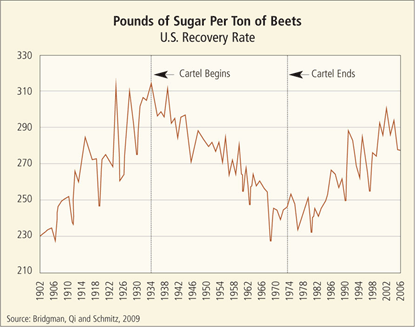Photo by Marc Norberg
 The word “cartel” usually conjures dark images of drug lords or oil producers, but it can also apply to something as, well, sweet as sugar. In the United States, the government established a legal cartel of the sugar industry for four decades, and the effects of that cartel are the focus of a recent Minneapolis Fed staff report, “The Economic Performance of Cartels: Evidence from the New Deal U.S. Sugar Manufacturing Cartel, 1934-74 ” (SR 437).
The word “cartel” usually conjures dark images of drug lords or oil producers, but it can also apply to something as, well, sweet as sugar. In the United States, the government established a legal cartel of the sugar industry for four decades, and the effects of that cartel are the focus of a recent Minneapolis Fed staff report, “The Economic Performance of Cartels: Evidence from the New Deal U.S. Sugar Manufacturing Cartel, 1934-74 ” (SR 437).
In economics, a cartel is any organization of producers or sellers of a good who collude to raise prices by controlling supply, effectively acting as a monopoly. Understandably, most research on cartels has focused on their ability to raise prices, but there are also reasons to believe they affect productivity.
First, in competitive markets, producers compete by driving down prices, but competition may also compel them to innovate, leading to increased productivity and economic growth. In contrast, a monopoly producer may have incentive to neither decrease price nor innovate.
Second, some cartels are government-organized, such as the U.S. sugar cartel and others set up in the 1930s as part of federal anti-Depression programs known collectively as the New Deal. Government planners might not be primarily concerned about productivity. The goal of most New Deal cartels, for example, was quite explicitly to prevent prices from falling.
While there is a lot of research on how monopolies and cartels influence prices, there is very little research on how they affect productivity.
A sweet case study
To help remedy this deficiency, James Schmitz of the Minneapolis Fed, along with Benjamin Bridgman of the Bureau of Economic Analysis and Shi Qi of Florida State University (both former Minneapolis Fed research analysts), examined the U.S. sugar cartel. Unlike other New Deal cartels that were short-lived, the sugar cartel was in effect for 40 years, providing a wealth of historical evidence for economic research. Good measures of productivity for sugar refining are available, a further boon to research.
When the cartel was set up in 1934, it had two main features. First, there were provisions limiting the supply of sugar. In addition to import quotas, firms that refined sugar were given sales quotas, which in effect kept new firms from entering. To protect incumbent farmers from the entry of new farmers, the cartel agreement set acreage quotas for farmers that were tied to precartel acreage.
The second main feature was a subsidy paid to farmers based on the amount of sugar contained in their crop, financed by a tax on the output of sugar refining factories. This overall arrangement lasted until 1974, when the world price of sugar skyrocketed, and the U.S. industry and politicians decided the program was no longer beneficial. U.S. sugar producers, however, continue to benefit from import quotas and other protections.
Running in place
The most visible effect of the cartel was how it limited supply. Acreage quotas prevented the entry of new farmers, but they also locked in the 1934 geographic pattern of sugar production. Though shifting land or labor prices might have made some areas more attractive to sugar producers, the cartel “distorted” production decisions by discouraging relocation: Refining factories wouldn’t move to new areas where farmers didn’t have quotas.
In fact, even though over the life of the cartel it became less costly to produce sugar beets in the Midwest than in the West—largely due to increasing relative land and labor costs in the latter (particularly California)—the industry remained primarily in Western and Plains states. The economists find that after the cartel ended, the share of national sugar beet production fell in Western states while it increased in Midwestern states, where production costs were lower.
By locking the industry into less productive regions, therefore, these cartel provisions reduced productivity.
Evidence from a “natural experiment”
The authors also argue that the cartel’s tax-subsidy scheme would have reduced productivity. Prior to the cartel, the only source of revenue to the industry was sugar actually extracted from beets at the factory. But the cartel’s subsidy to farmers introduced a new source of industry revenue, one tied to the total amount of sugar in the beet crops before extraction, calculated as the percentage of sugar in each beet times the total tonnage of beets produced.
This subsidy introduced another potentially productivity-hampering distortion. That’s because it encouraged farmers to produce larger crops with more total sugar, even though it resulted in lower-quality beets whose sugar was harder to extract at the factory.
In theory, then, the sugar cartel should have reduced quality and productivity. The authors offer an array of evidence that it did so in practice, as well. They look at the recovery rate—the amount of sugar produced per ton of beets processed. During the cartel, from 1934 to 1974, the recovery rate fell from 310 pounds of sugar per ton of beets to about 240 pounds. Not long after the cartel ended, the rate began to climb (see chart below).

Correlation isn’t proof of causality, so to build a stronger case that these changes were the effect of the cartel, the economists compare industry performance across regions. They argue that the subsidies should have led some regions, particularly California, to have greater reductions in recovery rates than others, such as the Midwest. Why? Arid areas using irrigation could increase beet tonnage (but reduce beet quality, as measured by recovery rate) by increasing irrigation close to harvest time. Areas reliant on rainfall couldn’t use this tactic.
Using factory-level data, the researchers find that the cartel reduced recovery rates in all areas, but rates fell further in California and other arid Western states than in the Midwest (down 5.3 pounds per year versus 2.1 pounds). This significant regional difference is consistent with the theory’s predictions.
Joe Mahon is a Minneapolis Fed regional outreach director. Joe’s primary responsibilities involve tracking several sectors of the Ninth District economy, including agriculture, manufacturing, energy, and mining.





